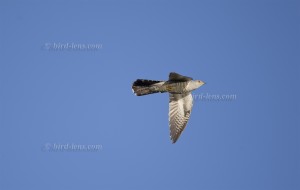 Migration time for the Common Cuckoo (Cuculus canorus). Hopefully, at this moment, a Cuckoo namend “Prinzregent” has reached tropical Africa already. For this endavour, the young Cuckoo has flown nearly 8,000 arduous kilometers. But where is he now. When he will return back in spring?
Migration time for the Common Cuckoo (Cuculus canorus). Hopefully, at this moment, a Cuckoo namend “Prinzregent” has reached tropical Africa already. For this endavour, the young Cuckoo has flown nearly 8,000 arduous kilometers. But where is he now. When he will return back in spring?
Answers to these questions are now monitored by a project of the “Landesbund für Vogelschutz in Bayern e.V” (Bavarian society for the protection of birds) (LBV). The LBV-action “Cuckoo, where are you?” is now online. The Internet site www.lbv.de/ cuckoo , can be used to follow live the route of “Princeregent” and 13 other cuckoos. For this purpose, the animals were fitted with satellite transmitters.
About the resting areas and the routes of Cuckoos breeding in Germany, and about her life in Africa, little is known. Migration routes and wintering areas of the cuckoo are largely unknown. To change this the LBV will pursue a groundbreaking, international project between 2013 to 2015. Together with partner societies several cuckoos are equipped in Middle and Eastern Europe with high-tech mini-satellite transmitters. Thus, migration routes and wintering areas can be explored. 15 cuckoos for example were equipped with these devices in the Danube Valley near Regensburg in Bavaria.
This project certainly provides exciting new data on migratory behavior and biology of the cuckoo.
Why such an expensive project? The cuckoo is in Germany on the Red List, as its population has fallen in the last 20 years by up to 50 percent. The main question is, weather this bird can adapt to climate change. The cuckoo lays its eggs in the nests of other birds. Probably as an adaptation to climate change many of these birds arrive earlier back from their wintering grounds. When the cuckoo is not bringing forward his arrival, it might be possible that he returns too late to find suitable nests for laying eggs.
The same time the LBV is taking effective protection measures based on his long experience. This includes the preservation of riparian forests along rivers. These are not only habitat of the cuckoo, but also serve as an effective flood protection. So “Prince Regent” will find an intact habitat when he passed his dangerous journey to Africa in spring.
Therefore, the LBV calls for donations to this project and thus to sponsor the cuckoo. With the donation, the transmission of the satellite data, the acquisition of new tracking device and protection of breeding areas is secured.
Although bird-lens.com is mainly a portal for bird images and stories around birds, bird-lens.com always support serious programs for the protection of birds with emphasis. This happened already with the LBV last year, when the Common Snipe was claimed “Bird of the Year 2013” by the NABU and the LBV, the NABU partner in Bavaria as you can see here.
Furthermore to cope with the growing demand for top shots of the rarer species of the Palearctic Bird-Lens is keen to enrich the range of pictures of birds you can find in the western palearctic. The nice images you find in that blog are only a first impression, what you will find in the gallery in the “Pictures Shop” very soon. Just give me a message, if I could serve you with an image needed before the new pictures are online.
Other successful shootings you can see under: www.bird-lens.com.